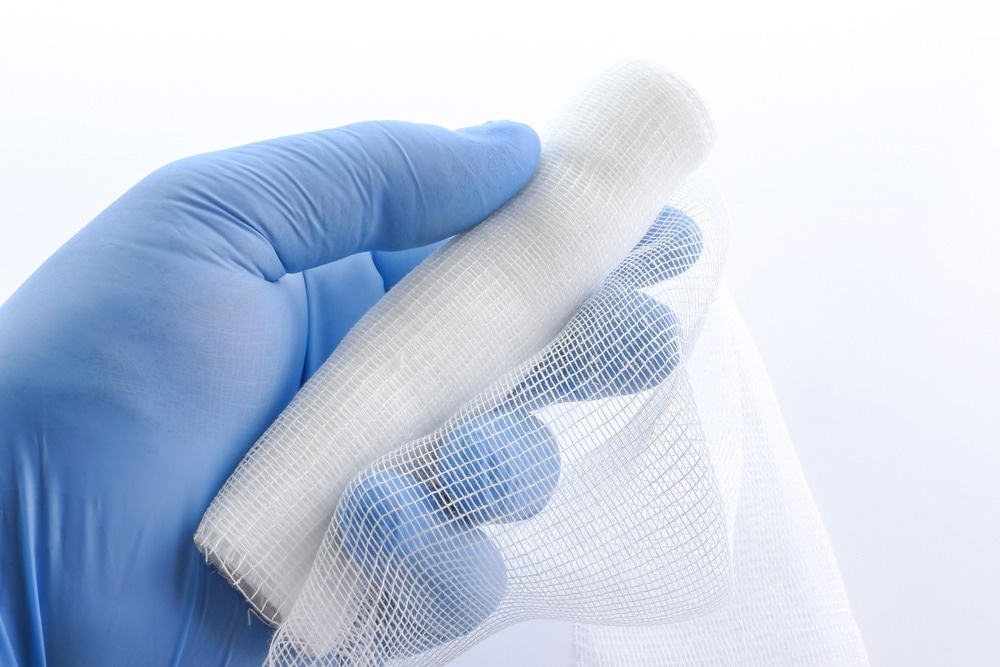Although several novel interventions were explored for wound healing, treating non-healing and chronic wounds is challenging in clinical management. In an article recently published in the journal ACS Applied Materials and Interfaces, researchers loaded RL-QN15 pro healing peptide into hollow silica nanoparticles, followed by their integration with zinc alginate (ZA) gels to form HSN@RL-QN15/ZA hydrogel.

Study: Zn2+ Cross-Linked Alginate Carrying Hollow Silica Nanoparticles Loaded with RL-QN15 Peptides Provides Promising Treatment for Chronic Skin Wounds. Image Credit: azazello photo studio/Shutterstock.com
The researchers observed that the fabricated hydrogels were biocompatible, hemocompatible, porous, and exhibited antimicrobial activity against broad-spectrum microorganisms. The hydrogels showed release of bioactive RL-QN15, which was advantageous to accelerating the healing process.
The fabricated hydrogels promoted skin proliferation, angiogenesis regulation, inflammation reduction, accelerated granulation/tissue formation, and re-epithelialization, resulting in fast healing of full-thickness skin wounds and chronic wounds in mice.
Recent Interventions in Wound Healing
Wound healing encompasses several processes, such as hemostasis, inflammation, proliferation, and remodeling involving various growth factors, cells, extracellular matrix (ECM), and cytokines. Various biological factors can interrupt this process, resulting in chronic wounds or non-healing. Specifically, the exposure of subcutaneous tissue to microorganisms due to skin rupture may cause wound infections, thus delaying the healing process and inducing tissue necrosis.
Wound healing interventions such as the application of topical agents and wound dressing should concurrently accelerate re-epithelialization and healing, inhibit microbial invasion, and diminish scarring. Although wound dressing can provide a conducive environment for wound healing, wound dressings such as polymer bandages, gauze, nanofibers, and films are ineffective in inhibiting bacterial infections. Furthermore, removing the wound dressings may cause secondary injury at the wound site.
Hydrogels are hydrophilic in nature with a three-dimensional (3D) cross-linked structure. The 3D porous structure can mimic the biological function of ECM to deliver bioactive compounds and consequently promote wound healing.
Alginate-based hydrogel is formed by the interactions between multivalent cations and the alginate chain’s negatively charged carboxyl groups. Calcium ion (Ca2+) based Ca-alginate hydrogels are extensively used in biomedicine to regenerate the skin or tissue and in 3D printing.
HSN is widely used to load the drug molecules. Additionally, incorporating nanoparticles into scaffolds can remodel the microenvironment in wound dressing during tissue regeneration. Previous reports show that drug-loaded silica nanoparticles or hydrogels embedded with silica nanoparticles can promote wound healing.
HSN@RL-QN15/ZA Hydrogel for Wound Healing
In the present study, the researchers combined the advantages of nanoparticles, hydrogels, and wound healing drugs. They loaded RL-QN15 peptides into HSNs and assembled them into ZA gels to form peptide-based HSN@RL-QN15/ZA hydrogels.
The team evaluated fabricated hydrogel characteristics, safety profiles and biological properties. Results revealed that the hydrogels were biocompatible and hemocompatible and exhibited sustained release of the RL-QN15 peptide drug, promoting in vitro and in vivo wound healing.
HSN@RL-QN15/ZA hydrogels showed antimicrobial activity against broad-spectrum microorganisms and promoted rapid healing of wounds infected with chronic methicillin-resistant Staphylococcus aureus (MRSA). The synergetic effects of ZA hydrogels and HSNs facilitated the sustained release of RL-QN15, which enhanced the pro-regenerative ability of the peptide drug.
The researchers treated wounds of full thickness in mice with PBS (control), HSN, ZA, RL-QN15, HSN@RL-QN15, and HSN@RL-QN15/ZA. They observed [SC2] that the groups treated with HSN@RL-QN15/ZA hydrogels showed the highest healing rate compared to the other groups, suggesting the role of the composite in enhancing the healing ability of RL-QN15.
Additionally, the fabricated hydrogels promoted keratinocyte scratch repair, skin cell proliferation, reduced inflammation, regulated angiogenesis, and accelerated granulation tissue formation and re-epithelialization that led to accelerated healing of MRSA and skin wounds.
RL-QN15 was observed to have excellent pro-regenerative properties. Its efficacy was enhanced by the slow-release behavior of HSN and ZA’s broad-spectrum antimicrobial activity. Thus, the triple combination of RL-QN15 peptide, ZA gel, and hollow HSN is a novel strategy for treating infected skin wounds.
Results highlight the efficiency of antimicrobial hydrogels encapsulated HSNs in loading peptides, designed as a new intervention in repairing skin wounds. The in vitro and in vivo studies indicated that the HSN@RL-QN15/ZA composite is a potent pro-regenerative dressing to treat chronic skin wounds.
Conclusion
In summary, the researchers prepared HSN@RL-QN15/ZA, a peptide-based hydrogel with good hemocompatibility and biocompatibility, sustained peptide release, and high porosity. Moreover, the fabricated peptide-based hydrogel induced cell proliferation and migration, vascular regeneration and its regulation, and inflammation, consequently accelerating wound healing.
The composite hydrogel exhibited antimicrobial activity against Gram-negative (Escherichia coli) and Gram-positive (Staphylococcus aureus) bacteria, MRSA, and fungal species (Candida albicans).
Such properties offered the prepared hydrogel with wound closure and infected wound healing ability. These findings suggest the multifunctionality of composite hydrogel, indicating its competitive candidature in wound dressing for treating drug-resistant bacteria-infected wounds with combined effects of peptide/nanoparticle/hydrogel.
Reference
Qin, P., Tang, J., Sun, D., Yang, Y., Liu, N., Li, Y et al. (2022). Zn2+ Cross-Linked Alginate Carrying Hollow Silica Nanoparticles Loaded with RL-QN15 Peptides Provides Promising Treatment for Chronic Skin Wounds. ACS Applied Materials & Interfaces https://pubs.acs.org/doi/10.1021/acsami.2c03583
Disclaimer: The views expressed here are those of the author expressed in their private capacity and do not necessarily represent the views of AZoM.com Limited T/A AZoNetwork the owner and operator of this website. This disclaimer forms part of the Terms and conditions of use of this website.